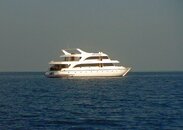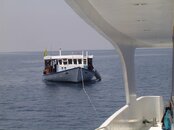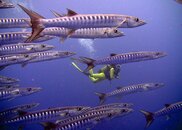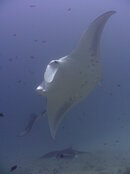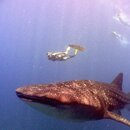Arturo
Contributor
I was aboard the Maldivian Dream from March 27 to April 03, 20010. Not being an underwater photographer, but recognizing the enrichment provided by images, I am including a small sample of the pictures taken by Marc Chicano during the liveaboard. More pictures will soon be available in my Picasa website. The trip report follows.
GETTING THERE.
I arrived on Male airport at 10 AM, on a British Airways (BA) flight from London Gatwick. Yes, you first have to flight to Europe and then proceed to the Maldives. Except for some charter flights, the only airline with regular non stop flights from Europe to Male is BA. In case you prefer to arrive into another European capital, then you have to flight either with Qatar or Emirates and change planes in Doha or Abu Dhabi, respectively. I discarded these options because total travel time was longer and they increased the risk of luggage mishap. If you chose to fly BA, however, be aware that their new regulations allow to dispatch one free 23 Kg. piece of luggage and 10 Kg. on your backpack or carry-on. No exceptions, unless you pay 30 additional pounds to dispatch a second luggage.
I walked out of the airport to find the chief instructor of the Maldivian Dream, Marc, waiting to boat me to the liveaboard, together with other divers that had arrived on an earlier Qatar Airlines flight. The airport is located on separate island and you need some sort of water transportation to get to your final destination. That would be a boat, for shorter distances, or a hydroplane for the more remote and exclusive resorts.
We were only eleven divers aboard the Maldivian Dream, which can take as much as 20 passengers. So plenty of room for all divers and I got a spacious 12 x 10 feet cabin just for myself. Four French, six Spaniard and I composed the group.
The two Spanish instructors, Marc and Marilen, speak fluent French and Spanish and good English. They have been continuously working as divemasters and instructors in the Maldives for 13 years, so they have an exceptional knowledge of those waters. This proved to be invaluable at the time to decide what to look for at each diving site, given the strong tidal influence on the atolls inflow and outflow currents and therefore in marine life. Both have also keen eyes to spot little critters, that otherwise would have gone unnoticed to our eyes.
All dives were performed from a large and comfortable dhoni - sail boat with a motor - that followed the Maldivian Dream carrying the compressor and Nitrox facilities, as well as all our gear throughout the week. This setup worked out wonderfully because it kept the main deck dry and clean and eliminated the noise generated by the compressors, because the dohni separates a few hundred meters from the mother boat every time it had to reload the tanks.
THE DIVING
Ours was the so called central Maldives itinerary and started with a few dives in North Male atoll. From there we moved on to South Male Atoll. Then we crossed west, to dive at famous Ari atoll, proceed North, to Rashdu atoll to finalize back in North Male atoll.
There are basically three types of dives in the Maldives: passes, usually with strong to ripping currents; outer reefs quasi standard reefs- with varying amount of current; and thilas, which are submerged pinnacles rising from the depth to a few feet below surface.
Passes congregate most of the hunting action by pelagic, such as grey and white tip sharks, tuna, jacks and barracudas. Outer reefs usually give the chance to watch mantas, napoleons, turtles, a large variety of morays and, hopefully, the whale shark. The thilas peak, on the other hand, collect an amazing amount of small critters and macro life: anemone fish, nudibranchs, leave and frog fish, etc.
My computer consistently indicated a water temperature between 28 and 29 °C, at 30 meters. So, no need for a wet suit; a rash guard at most. We performed eighteen dives during the week. Almost all dives were between 28 and 35 meters and lasted anywhere between 50 and 60 minutes. In spite of diving exclusively with Nitrox 28-30, and 15 lts. steel tanks, people often got into deco. Im a conservative diver and tried to stick to the PADI recreational diving concept. To stay away from deco I had to cut short most dives around 50 minutes. I was allowed to do so and surfaced alone on most dives. My good old safety sausage a must in the Maldives- and the keen eyes of the dhoni sailors brought me every time safely back onboard. Never had to use my Dive Alert to call their attention.
CONCLUSIONS
The Maldives exhibit very healthy reefs and I could see no residual effects of the devastating 1998 El Niño that killed most of the corals.
Their diving infrastructure is very good, taking into consideration that is a country with only 350,000 inhabitants. There are three operational recompression chambers in the Maldives, and you can even find a diving shop in the duty free zone at the airport (with some excellent prices, I might add).
As for marine life, except for the massive formations of hammerheads, typical of Galapagos and Coco, in the Maldives you can find and photograph most, if not all, of the other small and big creatures one can wish to encounter. Large squadrons of mantas, whale sharks, many of the indo-pacific macro usual suspects, and most of the pelagic predators such as jacks, sail fish, tuna, dolphins and sharks.
A word of caution, though: the Maldives is not a place for novice divers or for those not feeling comfortable in strong currents. Currents are always present and some times you have to kick real hard against them to reach your diving spot (such as the corner of a pass when there is outgoing current).
Most of the divers that visit the Maldives are Europeans rather than Americans. It is natural advanced diving destination for divers from EU zone after they have visited the Red Sea (which is closer and cheaper). The only reason I can think of why very few Americans venture to this destination is simply the long trip to get there.
This was my first trip to the Maldives and certainly it deserves at least a couple more trips to explore the northern and southern atolls. But even with this limited knowledge of what it has to offer, I would not hesitate in ranking the Maldives in the same category with other world class diving destinations such as Palau, PNG, Sipadan, Galapagos and Coco.




